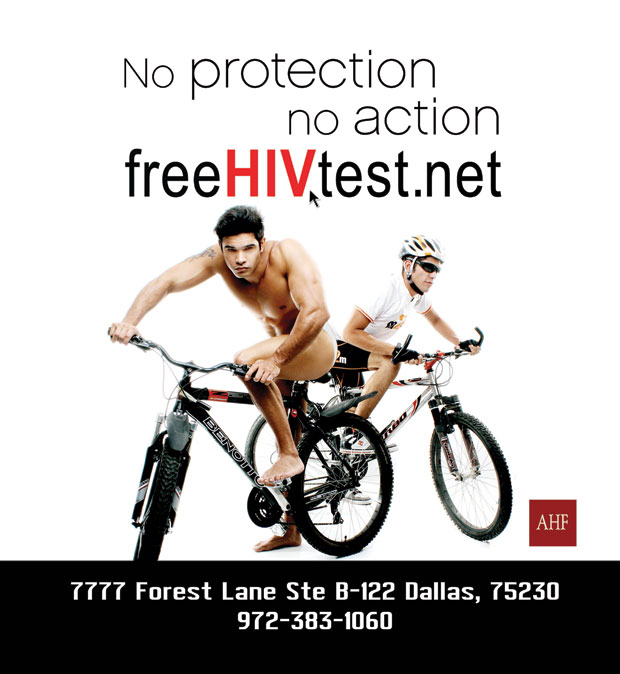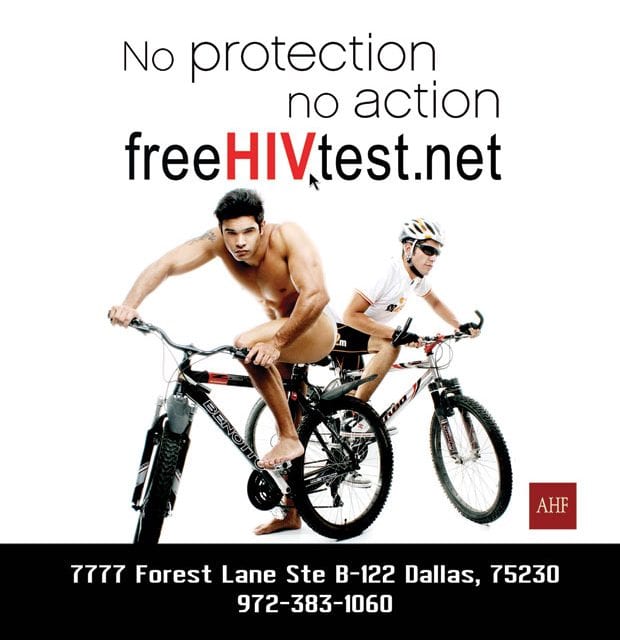The South is hard hit with HIV infection, but Ryan White funding hasn’t kept up with the shift

PREVENTION | AIDS Healthcare Foundation is releasing educational posters they hope will get people to test regularly for HIV.
Editor’s note: This is the first of a two-part series on Ryan White funding.
When Antonio Rivera moved to Sherman from Los Angeles five years ago, he thought he had escaped a life he described as “harrowing.” He’s been HIV-positive for over a decade, but he says limited accessibility to HIV specialists, counseling and nutritional programs is forcing him to return to California.
“I’ll be moving to Oxnard where my two sisters live,” he said. “I don’t want to go back, but I don’t have a car, and it’s not easy for me to get to the places I need to go. A lot of times, I miss doctor appointments because I can’t get there. That’s not good.”
According to Tim Boyd, director of domestic policy with AIDS Healthcare Foundation, California has 411 physicians who are HIV specialists. Compare that to 243 physicians who specialize in HIV in nine Southern states combined, including Texas.
“There are 275 physicians in New York state who are HIV specialists,” Boyd said. “You can see where Texas and the other Southern states are having a problem.”
Rivera’s access to physicians in California won’t be as restricted as what he’s experienced in Sherman, but it isn’t a move he wants to make.
“I’m poor,” he said. “I was raised in Los Angeles, and I lived in a really bad part of the city. Gang violence was high. It won’t be so bad this time in Oxnard, but I hate it that I have to go back there just because Texas doesn’t have the doctors California has.”
The shortage of HIV specialist physicians in the South is further burdened by a hefty rise in HIV infections. According to the Center for Disease Control and Prevention, both the number of people diagnosed with AIDS and the rate of AIDS diagnoses (number of diagnoses per 100,00 people) is highest in the South (15,855 diagnoses or 13.7 per 100,000 people). These are the figures for 2011, the latest statistic the CDC lists.
“HIV infections have shifted to the South,” Boyd said. “Earlier prevention efforts were focused in urban and gay communities, but HIV is stepping outside those areas. HIV is now hitting a population that didn’t get prevention messages before.”
So, has federal funding of agencies who provide HIV services followed that shift?
“No,” Boyd said, “Right now, the South doesn’t receive an equitable share of Ryan White funds. As an average, New York gets $800 person, but Dallas and Houston get less than $600.”
The Ryan White CARE Act was enacted in 1990 and is the largest federally funded program in the U.S. for people living with HIV/AIDS. The act sought funding to improve availability of care for low-income, uninsured and under-insured victims of AIDS and their families. Those funds, $2.3 billion, contribute significantly to many of the agencies who provide services to people living with HIV, but the federal government hasn’t adjusted the allocation of Ryan White funds to address the increase of HIV infections in the South.
“New York gets a lot because the way Ryan White funding is allocated is based on HIV cases in a metropolitan area,” Boyd said. “It’s tried to move away from that, but it hasn’t caught up with how HIV is shifting.”
AHF is nudging the federal government to address the disparity in how Ryan White funds are doled out. In March, the agency announced the introduction of the Ryan White Patient Equity and Choice Act, a bill to make needed improvements to how the funds are allocated. Rep. Eddie Bernice Johnson, D-Dallas, is one of the co-sponsors for the bill.
“This bill will help begin to ensure funding follows the HIV epidemic where it is growing and that Ryan White is better focused on ensuring more people get the care they need to stay healthy and become noninfectious to others.”
In a press release that addressed the bill, Boyd said, “Providers such as Medicaid and private insurance do not cover services like HIV care retention services, HIV medical case management and treatment adherence services — things that are essential to saving lives and stopping the spread of HIV. Moreover, these providers do not have the HIV expertise of the CARE act.”
Rivera agrees.
“The South is in the dark ages when it comes to HIV,” he said. “I think that’s part of why it’s become the center for new HIV infections in the country. I know this is the Bible Belt, and there’s a prejudice against gays, which is one of the groups so affected by HIV.”
Half of all new infections in the United States are in the South, although the region has only a little more than a third of the country’s population, accord to the CDC. The South also has the highest rate due to HIV.
Dallas is No. 1 in HIV infection per capita in the state, Boyd said, and there are many factors that contribute to that, including drug abuse, homelessness and using sex for survival.
“But we’re eliminating barriers and making HIV testing more accessible,” Boyd said.
If the federal government would shift more of the Ryan White funding to the hard-hit South, Boyd and others say they would be able to provide more services.
“Oh, my God,” said AIDS Services of Dallas CEO Don Maison. We’d be able to pay for food. We’d be able to pay for transportation for medical services. We’d be able to pay for medical case management.”
About 48 percent of Resource Center’s budget comes from Ryan White funding, according to CEO Cece Cox. If the South were to receive a more equitable share of the funds, she also would be in a position to offer more services to their clients.
Patients in the South, like Rivera, often live far from physicians who specialize in HIV. They can’t afford a vehicle and have trouble getting to their appointments, which might be up to 100 miles away. Once infected, poor people face hurdles that keep them from getting adequate care.
They often have no health insurance and little money for medication and tests. Blacks have been hit the hardest. They account for half of the men and nearly three-quarters of women in the South with newly diagnosed HIV infections, according to the CDC.
“A lot of gay black men in Dallas live on the ‘down low,’” Rodney Thompson said. “They live so-called ‘straight lives’ with their girlfriends and wives, but they’re having sex with men. In our community, a lot of people see being gay as immoral. It’s too bad because that’s one of the reasons the HIV infection rate is so high in Dallas.”
Thompson said he gets tested at least twice a year, but his family doesn’t want to know about it. As an out black man, he said he battles the prejudice against gays in his community.
“It’s about religion, I guess,” he said. “They’re just stuck on that. In the meantime, people are getting sick.”
With increased Ryan White funding, Boyd said AHF and other agencies can reach more people and offer more services.
“We’ve got to resolve this disparity in how the funds are allocated,” he said. “With increased funding, Texas and Dallas and Fort Worth can better meet the need of people with HIV. It’s hard enough for an area like Tarrant County to meet the existing needs of people with HIV with the funds they do have.”
Right now, though, Rivera thinks it’s too late for him.
“Not so,” said a Dallas AIDS activist. “While increased Ryan White funding would provide additional services, there are already many services available to him in North Texas, including free medical care, clinics and transportation that he needs to access. Even with their current budgets that don’t get the share of Ryan White funds we should receive, Dallas area agencies are doing a great job serving people with HIV.”
This article appeared in the Dallas Voice print edition April 4, 2014.
















